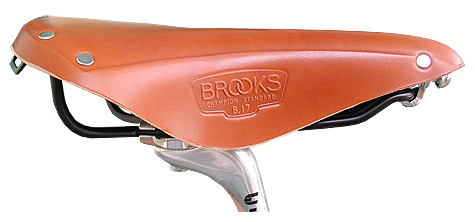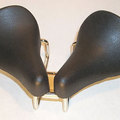 Cyclists shouldn’t be suffering a lot of fear and loathing over the possibilities of male impotence caused by bike saddles. Anyway, isn’t anxiety a major cause of erectile dysfunction?
Cyclists shouldn’t be suffering a lot of fear and loathing over the possibilities of male impotence caused by bike saddles. Anyway, isn’t anxiety a major cause of erectile dysfunction?
The New York Times interviewed several specialists in a story this week (“Serious Riders, Your Bicycle Seat May Affect Your Love Life”) that concludes that most bike saddles do little to protect the sex organs. One study found 5% of male cyclists reported problems.
I’ve done a little checking around after blogging on the original story (“Bicycle saddles becoming an issue of mounting concern”) and found that these concerns are way old news. Many bike experts have studied the dysfunction at the junction and offered suggestions on how to avoid or fix saddle problems.
Back in 1999, Charles McCorkell, owner of Bicycle Habitat in New York City, spoke to urologists about erectile dysfunction and poked holes in several studies that had been done at that time.
One study (AUA abstract 952) reported that cyclists were twice as likely to suffer severe impotence as swimmers. McCorkell noted that the swimmers in the study averaged 10 years younger and the study didn’t report the margin of error, which would have made the two groups fairly even. He continues:
“The final blow to this survey came when a colleague of mine, Bud Hoffacker, the owner of Avocet cycling products, graphed the impotency rates of the cyclists against the findings of the Massachusetts Male Aging Study and demonstrated that when compared to the general male population, cyclists were half as likely to suffer severe impotence and 1/3 as likely to suffer any more of impotence.”
 Before the onset of erectile dysfunction, cyclists usually feel numbness after their rides. That’s when it’s time to adjust the bike fit, change the saddle or riding style, McCorkell said. Most decent bike shops have at least one person qualified to recommend changes.
Before the onset of erectile dysfunction, cyclists usually feel numbness after their rides. That’s when it’s time to adjust the bike fit, change the saddle or riding style, McCorkell said. Most decent bike shops have at least one person qualified to recommend changes.
If there’s no bike shop nearby, Jim Langley, a former editor at Bicycling Magazine, offers a tutorial on bike fit at his website. To help with bike fit, He starts with the saddle angle and height, then tells about shoe cleat adjustments, fore and aft position, and handlebar height, reach and size.
A special guide to the saddle explains that faster cyclists tend to put more weight on their feet and hands; slower cyclists on cruiser style bicycles plant more weight on their rear, Langley explains.
“A lot of people look at the typical narrow bike seat found on a modern road or mountain bike and wonder what demented individual designed such an obvious torture device. … the modern bicycle saddle is a sophisticated invention that took about 150 years to develop.”
Langley also offers a troubleshooting guide for bike fit problems.
Another bike expert, Sheldon Brown, writes about bicycle saddles at his website. He looks at the history of recreational cyclists’ bike saddles and explains why they’re built they way they are.
As for male impotence, he writes:
“… it is my opinion that these problems in most cases are related to poor adjustment or poor choice of saddles, such that the rider’s weight is not being carried properly by the “sit bones.” In particular, having the saddle too high or tilted down too far, will lead to the rider sitting on the narrow part of the saddle, which may block these arteries, and also possibly do nerve damage. This sort of mismatch can also create pressure on the prostate.”
The answer, says Brown, proper bike fit or checking out other saddles. In extreme cases, he suggests switching to a recumbent.
What all this tells me is that the growing popularity in cycling will not lead to a worldwide pandemic in male impotency. If you suffer numbness or discomfort, check the bike fit. If that doesn’t help, look for a saddle that matches your riding style or body shape. Increasing miles doesn’t have to mean decreasing fertility.

Recent Comments